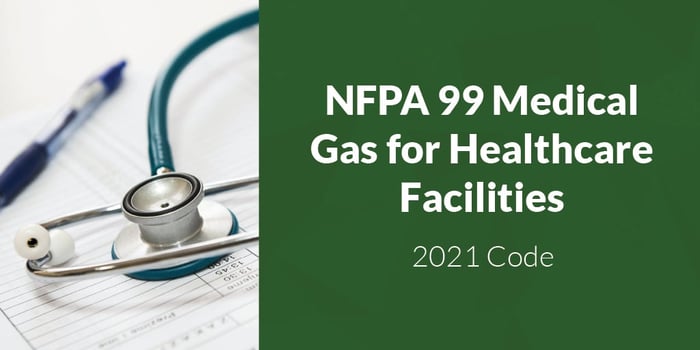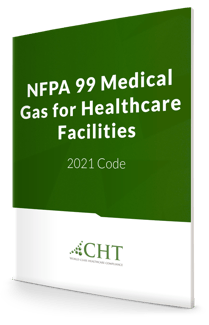
As with most healthcare aspects, medical gas systems continue to evolve to provide a safer, more effective patient experience. The NFPA 99 Health Care Facilities Code is no exception, and the 2021 edition has some noteworthy changes and additions of which facility managers should be aware.
What is the NFPA 99 2021 code?
The 2021 National Fire Protection Association code (NFPA 99) is a healthcare facilities code that establishes criteria for levels of healthcare services or systems based on risk to patients, staff, or visitors. It delivers the foundation for building risk-based performance criteria for the healthcare facility's environment.
This most recent edition was published in October 2020. While there is no current indication the 2021 edition will be adopted by the Centers for Medicare & Medicaid Services (CMS), some of the updates highlight the importance of having qualified individuals managing and maintaining medical gas systems.

New Additions to the NFPA 99 2021 Code
Going back to the 2012 edition of NFPA 99, the document addressed the importance of the operation and management of medical gas systems. This portion of the code continued to evolve in the 2012, 2015, and 2018 editions, and 2021 follows suit.
One of the most significant additions to the 2021 code is the role of the Responsible Facility Authority and the Permit-to-Work system's evolution. While the wording of a Responsible Facility Authority has been part of previous editions, the 2021 edition more adeptly defines the required qualifications and responsibilities.
Responsible Facility Authority Role
This position shall be a person or persons responsible for implementing NFPA 99 medical gas requirements within the facility.
Among the responsibilities, they shall be involved in the following:
- Advising on the facility’s assessment to determine risk categories of various spaces
- Interpretations of the code
- A medical gas emergency plan
- Development and enforcement of a Permit-to-Work system
- Evaluation and acceptance of medical gas verification reports
- Maintaining all inspection, testing, & maintenance (ITM) reports
The individual(s) designated as the Responsible Facility Authority is required to demonstrate a level of competency. This can be achieved through meeting the requirements of an ASSE 6010 Medical Gas Systems Installer, 6020 Medical Gas Systems Inspector, 6030 Medical Gas Systems Verifier, or 6040 Medical Gas Systems Maintenance Personnel. However, instead of attaining one of these credentials, the individual can also qualify by completing an educational program equivalent or superior to the ASSE credentials noted above.
Permit-to-Work System
The inclusion of a documented Permit-to-Work system in the code is a step forward in providing a safe and efficient method of performing routine maintenance, repairs, and medical gas system installations by ensuring proper communication and protocols are being adhered to by facility staff.
In addition to shutdown procedures, the Permit-to-Work system shall require proper testing on affected portions of the medical gas system after any work is performed to effectively “close the loop.”
New Requirements for the Emergency Oxygen Supply Connection
From a design perspective, the Emergency Oxygen Supply Connection (EOSC) is now required to include master alarm connection points to monitor the temporary supply of oxygen. NFPA 99 has always applied to all medical gas installations, including temporary installations.
However, monitoring a temporary supply of oxygen has previously been difficult since additional, often temporary, wiring was needed to be installed prior to connection to the EOSC. In a real emergency, installing this wiring was unlikely, and unfortunately, the system was not adequately monitored. This addition rectifies this condition moving forward.
Installation Process Requires a System Inspection
A notable inclusion in the installation process is the requirement of a system inspection following the installer performed tests required in 5.1.12.2 but before the final system verification.
The primary goals of this system inspection are to identify any system leaks and ensure proper component labeling prior to any piping being concealed behind walls, ceilings, etc. This inspection is to be performed by a qualified ASSE 6030 Verifier or an ASSE 6020 Inspector. That individual is also required to witness the initial pressure tests required by the installer.
Decommissioning Portions of Medical Gas Systems
Aside from installation requirements, for the first time, NFPA 99 now addresses the issue of decommissioning portions of medical gas systems. While not an extensive explanation within the code itself, Annex A does provide the user with some basic recommendations.
However, it is essential to remember that information in the annexes are recommendations and not requirements of the code.
Conclusion
While these are just a few of the changes and updates to NFPA 99, the document continues to evolve with the ever-changing world of healthcare to provide a safe environment for patients, staff, and visitors.
And as previously noted, those individuals' expertise and qualifications in maintaining these critical utility systems remain paramount to an effective management program.
As these changes develop, CHT will keep you informed.
For help in determining how to apply NFPA 99 to your facility, contact your CHT representative today. Our knowledgeable staff can assist in navigating through NFPA 99.




